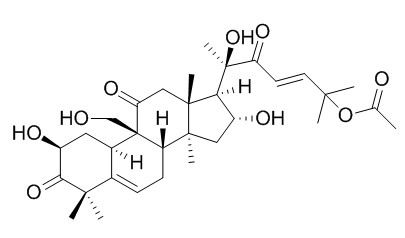Cucurbitacin A
Cucurbitacin I, cytotoxic triterpenoid sterols isolated from plants, elicits the formation of actin/phospho-myosin II co-aggregates by stimulation of the RhoA/ROCK pathway and inhibition of LIM-Kinase.
Inquire / Order:
manager@chemfaces.com
Technical Inquiries:
service@chemfaces.com
Tel:
+86-27-84237783
Fax:
+86-27-84254680
Address:
1 Building, No. 83, CheCheng Rd., Wuhan Economic and Technological Development Zone, Wuhan, Hubei 430056, PRC
Providing storage is as stated on the product vial and the vial is kept tightly sealed, the product can be stored for up to
24 months(2-8C).
Wherever possible, you should prepare and use solutions on the same day. However, if you need to make up stock solutions in advance, we recommend that you store the solution as aliquots in tightly sealed vials at -20C. Generally, these will be useable for up to two weeks. Before use, and prior to opening the vial we recommend that you allow your product to equilibrate to room temperature for at least 1 hour.
Need more advice on solubility, usage and handling? Please email to: service@chemfaces.com
The packaging of the product may have turned upside down during transportation, resulting in the natural compounds adhering to the neck or cap of the vial. take the vial out of its packaging and gently shake to let the compounds fall to the bottom of the vial. for liquid products, centrifuge at 200-500 RPM to gather the liquid at the bottom of the vial. try to avoid loss or contamination during handling.
J Enzyme Inhib Med Chem.2019, 34(1):134-143
PLoS One.2018, 13(4):e0195642
Biosci Biotechnol Biochem.2020, 84(3):621-632
Oncol Rep.2021, 46(2):166.
RSC Advances2017, 86
Plant Methods.2017, 13:108
Plant Archives2020, 2(1),2929-2934
Arabian Journal of Chemistry2024, 17(3):105648
J Agric Food Chem.2020, 68(51):15164-15175
Biochem Biophys Res Commun.2019, 518(4):732-738
Related and Featured Products
Biochem. Pharmacol., 2015, 102:45-63.
Cucurbitacin I elicits the formation of actin/phospho-myosin II co-aggregates by stimulation of the RhoA/ROCK pathway and inhibition of LIM-kinase.[Pubmed:
26707799 ]
Cucurbitacins are cytotoxic triterpenoid sterols isolated from plants. One of their earliest cellular effect is the aggregation of actin associated with blockage of cell migration and division that eventually lead to apoptosis.
METHODS AND RESULTS:
We unravel here that cucurbitacin I actually induces the co-aggregation of actin with phospho-myosin II. This co-aggregation most probably results from the stimulation of the Rho/ROCK pathway and the direct inhibition of the LIMKinase. We further provide data that suggest that the formation of these co-aggregates is independent of a putative pro-oxidant status of cucurbitacin I.
CONCLUSIONS:
The results help to understand the impact of cucurbitacins on signal transduction and actin dynamics and open novel perspectives to use it as drug candidates for cancer research.



